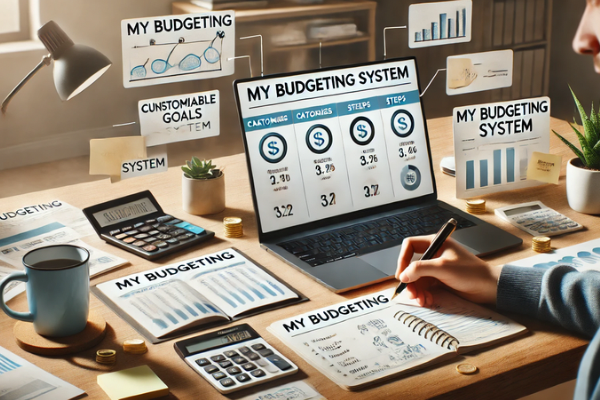Budgeting is one of the most powerful tools for taking control of your financial life. But not all budgeting systems are created equal—what works for one person might feel restrictive or confusing for another. The key to success is creating a system that fits your lifestyle, your habits, and your goals. A good budgeting system isn’t just about numbers; it’s about building a structure that supports the life you want to live.
In this article, we’ll walk through the steps to create a personalized budgeting system that you can stick to. Whether you’re just starting out or looking to refine your approach, these strategies will help you build a system that feels natural and effective.
Step 1: Understand Your Why
Before you build your budget, take time to understand your motivation. Why do you want to manage your money better? What do you hope to achieve?
Your “why” could include:
- Getting out of debt
- Building an emergency fund
- Saving for a home
- Reaching financial independence
- Reducing financial stress
When your budget has a clear purpose, it becomes a powerful tool to help you stay focused and motivated—even when sticking to the plan gets tough.
Step 2: Choose a Budgeting Method That Fits You
There are several popular budgeting methods. Choosing one that matches your personality and lifestyle makes budgeting easier and more sustainable.
Zero-Based Budgeting
In this method, every dollar has a job. Your income minus your expenses equals zero. You plan out every dollar you earn, allocating it to spending, saving, or debt repayment. This method gives you complete control and is great for those who like structure and detail.
50/30/20 Rule
This simplified method breaks your budget into three categories: 50% for needs, 30% for wants, and 20% for savings and debt repayment. It’s ideal for those who prefer broad guidelines without tracking every expense.
Envelope System (Cash-Based)
With this approach, you use cash for specific categories like groceries or entertainment and place it into envelopes. Once the envelope is empty, you stop spending. It’s a hands-on method that builds discipline, especially for impulse spenders.
Pay Yourself First
With this system, you prioritize saving and investing before spending. As soon as you get paid, a portion goes directly to savings or debt, and you live off the rest. It’s great for goal-oriented individuals who want to build wealth over time.
Whichever method you choose, make sure it aligns with how you think and behave around money. You can also mix and match methods to suit your needs.
Step 3: Track Your Income and Expenses
To build a functional budget, you need to know exactly how much money is coming in and going out each month. Start by listing all sources of income, such as:
- Salary or wages (after taxes)
- Freelance or side gig earnings
- Government benefits
- Rental or investment income
Then, track your expenses. Review bank statements, receipts, and credit card transactions to identify your spending patterns. Break expenses into fixed and variable categories:
Fixed Expenses:
- Rent or mortgage
- Utilities
- Insurance
- Loan payments
Variable Expenses:
- Groceries
- Transportation
- Dining out
- Entertainment
- Clothing
Don’t forget irregular or annual expenses like car maintenance, holidays, or memberships. Include them by estimating a monthly average and saving accordingly.
Step 4: Set Realistic Spending Limits
Now that you understand your income and expenses, assign realistic amounts to each category based on your chosen budgeting method. Prioritize essentials and savings, then allocate the remainder to non-essentials.
Be honest with yourself. If you typically spend $300 a month on dining out, don’t suddenly cut it to $50 unless you have a solid plan for how to adjust your habits. A sustainable budget meets your needs while allowing room for your values and lifestyle.
Step 5: Automate What You Can
Automation reduces the risk of forgetting payments or failing to save. Set up automatic transfers for:
- Bill payments
- Savings contributions
- Debt payments
Automation brings consistency and removes the temptation to spend money that’s meant for other purposes. It also makes your budget easier to manage over time.
Step 6: Track and Review Regularly
A budget is not a set-it-and-forget-it tool. Your financial situation and goals may evolve, and your budget should too. Check in weekly or monthly to see how you’re doing.
Ask yourself:
- Did I stay within my limits?
- Are my spending habits aligned with my goals?
- Do I need to adjust any categories?
Make adjustments based on what’s working and what’s not. Budgeting is a process, and improvement comes with consistency and reflection.
Step 7: Include Room for Flexibility and Fun
Budgets that are too rigid often fail. Life is unpredictable, and unexpected expenses—or opportunities—will arise. Build in a buffer for unexpected costs and a category for guilt-free spending, so you can enjoy your money without derailing your plan.
When you allow flexibility, you’re more likely to stick with your system long term.
Step 8: Keep Your Goals Front and Center
Your budget should be a reflection of what you value most. Whether it’s becoming debt-free, saving for a home, or retiring early, keep your goals visible. Use visual trackers, notes, or reminders to stay connected to your “why.”
When your budget supports your dreams, it becomes a powerful tool for transformation—not a list of restrictions.
Final Thoughts: Build a System That Works for You, Not Against You
There is no one-size-fits-all approach to budgeting. The best budgeting system is the one you’ll actually use—one that fits your life, respects your habits, and supports your goals. By creating a system that feels natural, flexible, and purposeful, you give yourself the tools to take control of your finances and build a more secure and intentional future.
Start small, stay consistent, and remember: your budget is there to serve you, not stress you out. Make it work for you—and watch your financial confidence grow.
